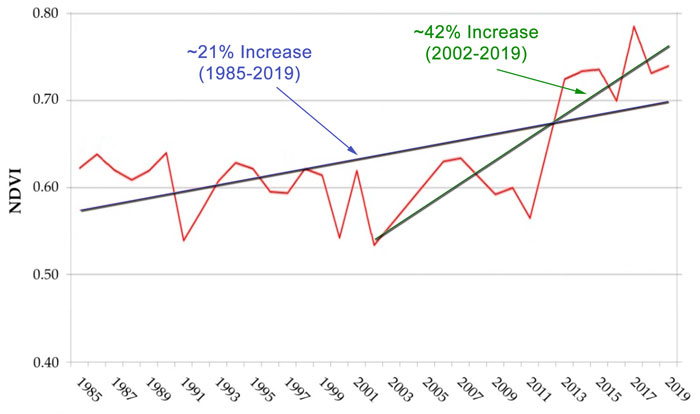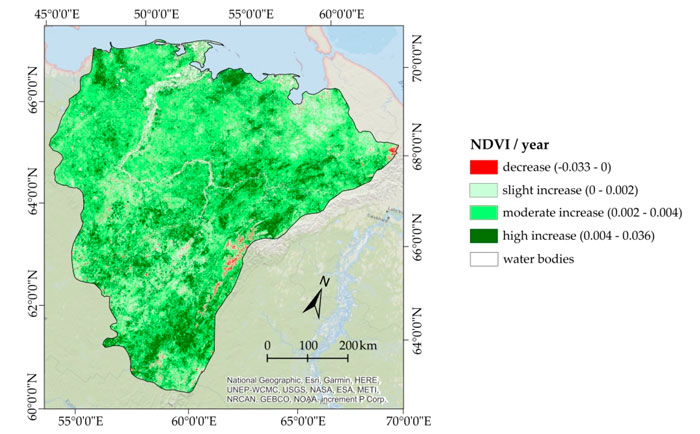The Greening of the Pechora River Catchment, Russian European Arctic
Chetan, M.-A., Dornik, A., Ardelean, F., Georgievski, G., Hagemann, S., Romanovsky, V.E., Onaca, A. and Drozdov, D.S. 2020. 35 years of vegetation and lake dynamics in the Pechora Catchment, Russian European Arctic. Remote Sensing 12: 1863, doi:10.3390/rs12111863.
For many years global warming alarmists have hypothesized that rising temperatures should be changing high-latitude Arctic ecosystems from carbon sinks to carbon sources, further exacerbating their projections of human-induced climate change by adding to the atmosphere’s burden of greenhouse gases and hastening that portion of the biosphere’s inevitable degradation.
But are the world’s high-latitude terrestrial regions truly becoming vegetative wastelands in response to rising temperatures and increases in atmospheric CO2?
With the advent of satellites, scientists have been able to make robust assessments of the situation, revealing in nearly every situation that terrestrial ecosystems in high latitude regions (and, in fact, all across the Earth) are not transforming into vast wastelands or carbon sources. Rather, they are becoming increasingly greater sinks; in response to a warming climate and rise in atmospheric CO2 vegetative productivity (i.e., satellite greening) has been increasing over the past several decades (see the many reviews we have posted on this topic in our Subject Index under the subheadings of Biospheric Productivity found on this page).
The latest such study to illustrate such enhanced greening comes from the work of Chetan et al. (2020). Focusing on the Pechora River Catchment, a high-latitude region in the Russian European Arctic comprising over 400,000 square kilometers, the team of eight researchers analyzed summer-season (July-August) satellite Normalized Difference Vegetation Index (NDVI, a measure of vegetative photosynthetic activity and robustness) data over the 35-year period 1985-2019. The results of that analysis are summarized in the two figures below.
Figure 1 displays the annual NDVI values for the Pechora Catchment. As indicated, the record displays year to year variability superimposed on a long-term linear increase in NDVI, which rise is calculated as approximately 21% over the 35-year record (or about 0.6% per year; blue trend line in the figure). However, the rise in NDVI is even stronger over the past two decades (approximately 42% from 2002 to 2019; the green trend line in the figure). What is more, almost all of the catchment area experienced an increase in NDVI across the study period, evidenced by the near-ubiquitous green shading illustrated in Figure 2.
In light of the above, it would appear that the alarmist hypothesis of Arctic ecosystem collapse, from carbon sinks to carbon sources (i.e., satellite browning), in consequence of rising temperature and atmospheric CO2 is falsified for the Pechora River Catchment, as it is with most everywhere else on the planet (again, see the many reviews posted on this topic in our Subject Index under the subheadings of Biospheric Productivity found on this page). In contrast, rising temperature and atmospheric CO2 are stimulating biospheric productivity to levels not seen for possibly millions of years.

Figure 1. Annual NDVI values for the Pechora Catchment over the period 1985-2019 (red line), revealing a long-term (~21%) greening since 1985 (blue line) and a much larger short-term greening of ~42% since 2002 (green line). Adapted from Chetan et al. (2020).

Figure 2. Annual trend slope of vegetation multi-spectral indices within Pechora catchment. Note the overwhelming spatial increase indicating widespread greening over the period of study (1985-2019). Source: Chetan et al. (2020).
This article appeared on the CO2 Science website at http://www.co2science.org/articles/V23/sep/a8.php
]]>